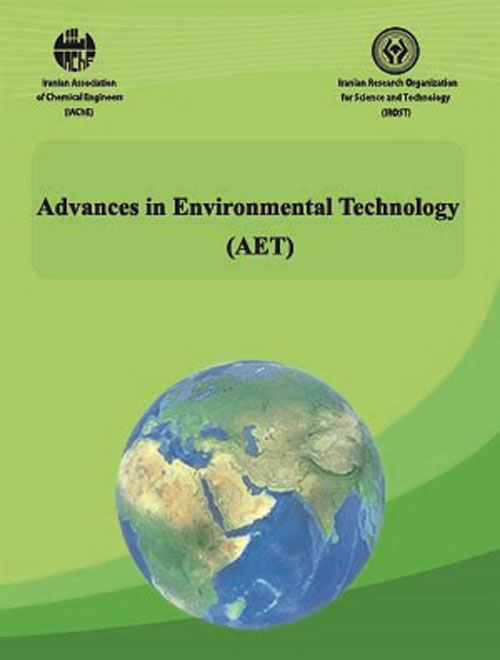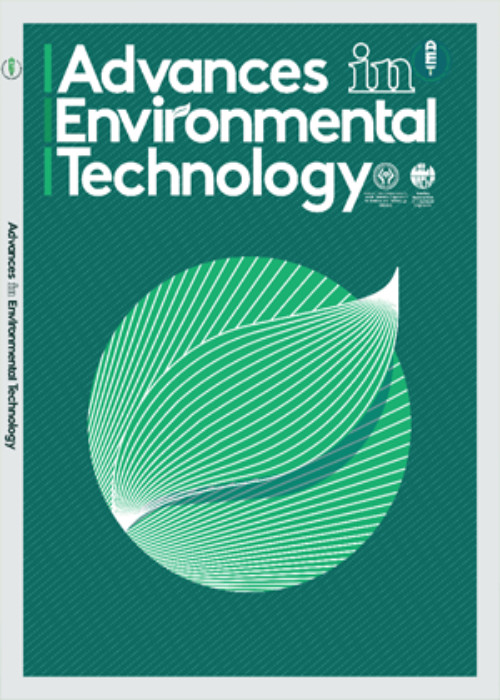فهرست مطالب

Advances in Environmental Technology
Volume:1 Issue: 3, Autumn 2015
- تاریخ انتشار: 1395/04/14
- تعداد عناوین: 6
-
-
Pages 105-111A membrane bioreactor (MBR) system based on a dead-end immersed hollow fiber membrane and filamentous fungus Aspergillus oryzae were used for treatment of bakers yeast wastewater. The fungus was adapted to the wastewater in the bioreactor for two weeks before starting the continuous process. Average organic loading rate of 4.2 kg COD/m3.d was entered the bioreactor. MBR system was able to reduce the COD and BOD5 of the wastewater from 5000 and 1400 mg/L to 488 and 70 mg/L, respectively, over a period of 45 days, while the turbidity of the wastewater reduced from 134-282 NTU to less than 2.5 NTU in the permeate stream. Critical flux and a suitable operating flux were determined as 6.7 and 5 L/m2 h, respectively. The obtained results confirm that the MBR system was able to efficiently reduce the turbidity and suspended solid of the wastewater by 99.4% and 98.3%, respectively, resulting in a clear effluent.Keywords: Baker's yeast wastewater, Hollow fiber membrane, Membrane bioreactor, Membrane fouling, Wastewater treatment
-
Pages 113-120With the wind permanent flow in the cities, obtaining the minimal pollution in the environment is accessible. Different policies have been considered for optimization of cities such as attachment and or reduction of building parts like air-traps, ceiling forms and so on. Due to population growth in cities and the increasing need for resettlement these people in the cities, inevitably, to the high-rise buildings have gone. The people living in high-rise buildings to meet the needs of their vital urban open spaces are forced to use. To have knowledge about air pollution through buildings, the CFD based software of Envi-met is used. In this case, we can say that the best angle to transfer pollution is the angle of 30 degrees. Also in an ideal case with imposed changes in the form, we could enhance the problem by better navigation of inside wind of urban canyons into spaces between blocks of buildings that have the capacity to trap the particles. Final it is found that we may be able to have more optimal results for transition of pollutions by suitable orientation of blocks against the wind direction of blow.Keywords: Pollution, urban block, urban canyons, CFD, Envi, met
-
Pages 121-127Environmental contamination, which is growing around the world, is a serious problem can not to be neglected. Among all contaminations, water pollution is a major problem. Azo dyes are one of the largest groups of pollutants found in the drinking water, coming from, and the food and textile industries. TiO2/Fe3O4 and TiO2/Fe2O3 nanocomposites with various ratios were synthesized by an ultrasonic-assisted deposition-precipitation method and their UV-light decolorization of methyl orange (MO) dye was investigated. The effect of Fe3O4/TiO2 and Fe2O3-TiO2 nanocomposites ratio on the photocatalytic activity and magnetic property of the nanocomposites was studied by comparing their decolorization curves and magnetism in the presence of magnet, respectively. The results revealed that the decolorization efficiency of 1 wt% Fe3O4/TiO2 nanocomposite reached about 40% within 60 min UV irradiation at room temperature. However, this sample showed the least magnetism. Also, the ability of synthesized nanocomposites in holding the adsorbed methyl orange dye on their surface and the effect of pH were investigated.Keywords: TiO2, Fe3O4, TiO2, Fe2O3 nanocomposites, Ultrasonic, assisted deposition, precipitation method, Photocatalytic activity, Methyl orange
-
Pages 129-135In this present study the dissolved air flotation (DAF) system was investigated for the treatment of Kermanshah Oil Refinery wastewater. The effect of three parameters on flotation efficiency including of flow rate (outflow from the flotation tank), saturation pressure and coagulant dosage on chemical oxygen demand (COD) removal was examined experimentally. All the experiments were done under a certain time (in this case 3 min). After final testing maximum COD removal efficiency was obtained 67.86%. In the next step of study, response surface method (RSM) was applied to model oil refinery wastewater COD removal as a function of flow rate, saturation pressure and coagulant dosage. Coefficient of determination, R2, showed that the RSM model can explain the variation with the accuracy of 0.996, indicating there was strong correlation. Moreover, process optimization were performed to predict the best operating conditions using RSM method, which resulted in the maximum COD removal of the oil refinery wastewater. The maximum COD removal of oil refinery wastewater was estimated by RSM to be 67.87% under the operational conditions of flow rate (3.76 3.86 L/min), saturation pressure (4.99 - 5bar) and coagulant dosage (24.16 24.79 mg/L).Keywords: Dissolved air flotation, chemical oxygen demand, response surface methodology
-
Pages 137-146Existence of 2-methylpropane-2-thiol as an organosulfur and odorant compound in the soil could causes environmental problem and social dissatisfaction. In this study, remediation of this type of thiol using ultrasound is investigated. Central Composite Design (CCD) based on Response Surface Model (RSM) was used to obtain effects of the main factor (Power, sonication time and amount of water) and their interactions. Analysis of variance and Pareto analysis shows that all main factors are effective (the percentage effects of 43.30%, 30.35% and 9.62% on removal efficiency for power, sonication time and amount of water respectively). Moreover, interaction between water content and power, and sonication time and power are effective interaction (with P-values of 0.025 and 0.007 respectively). Base on experiment results and analysis of variance effects of the daylight is not significant (P-value=0.825). P-value of lack of fit (0.176) suggested model assessed as a good model and adequately fits data. Highest levels of power and sonication time (86 watt and 38 minute respectively) and water content in lower level (27 ml) in studied interval lead to maximum removal efficiency (82.83%).Keywords: Soil remediation, Sonication, 2, methylpropane, 2, thiol, Mathematical modelling, Optimization
-
Pages 147-161The performance of olive stone activated carbon (OSAC) for sorption of Cu2, Zn2 and Ni2 ions was investigated via batch technique. OSAC materials were prepared under different physially activation conditions. Olive stone waste was physically activated with N2 gas and steam gas at 900oC at 3.5h hold time (OSAC-3) was choice as the best one for Cu2, Zn2 and Ni2 removal. Characterization for OSAC-3 were performed under BET-surface area, SEM, density and FTIR-spectrum. Optimum adsorption conditions were specified as a function of agitation time, initial metal concentration, pH and temperature. Kinetic results were found to be fast and described well by the pseudo-second order model. The adsorption capacities are 25.38mg/g (Cu2), 16.95mg/g (Zn2) and 14.65mg/g (Ni2) which followed the sequence Cu2 > Zn2 > Ni2. Spontaneous adsorption for all the studied cations, endothermic nature for both Zn2 and Ni2 ions and exothermic nature for Cu2 ions were obtained. The results showed that OSAC-3 is a good economical material for Cu2, Zn2 and Ni2 remediation from weakly acidic contaminated effluents.Keywords: Sorption, Cu(II), Zn(II), Ni(II), Physically activation Olive stone


